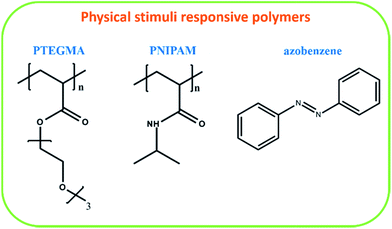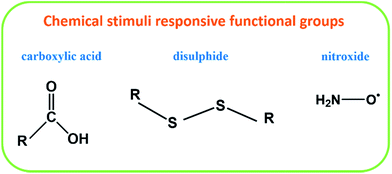Smart functional polymers – a new route towards creating a sustainable environment
V. Anand Ganesh*a,
Avinash Baji*a and
Seeram Ramakrishnab
aDivision of Engineering Product Development, Singapore University of Technology and Design (SUTD), Singapore – 138682, Singapore. E-mail: anand_ganesh@sutd.edu.sg; avinash_baji@sutd.edu.sg
bDepartment of Mechanical Engineering, Center for Nanofibers & Nanotechnology, National University of Singapore, Singapore – 117576, Singapore
First published on 9th October 2014
Abstract
Smart functional polymers have gained a huge amount of interest in recent times due to their innumerable applications in areas including sensors, actuators, switchable wettability, bio-medical and environmental applications. Numerous intensive research studies have been carried out to develop smart functional polymers using stimuli responsive polymeric moieties. This review article encapsulates recent developments in the area of smart functional polymers with a focus on various (physical, chemical and biological) stimuli responsive systems and their applications. Furthermore, this review also provides useful insights and in-depth analysis on the feasibility of utilizing stimuli responsive polymeric materials/composites in anti-fouling and water harvesting applications which hold tremendous potential to create a sustainable environment.
1. Introduction
Many living creatures in nature have perfected the art of responding to various adverse external stimuli. A few naturally existing stimuli responsive creatures include the leaves of Mimosa pudica (collapses immediately when touched), Venus flytrap (closes fast enough to catch its prey), sea cucumbers (change their stiffness in the face of danger), chameleons (change colour according to the nature of the environment) and sunflowers (follow the movement of the sun) etc.1–3 Researchers studied these naturally existing beings and discovered that the responsive nature is primarily due to the presence of bio-macromolecules or biopolymers such as proteins and collagens etc. For example, in sea cucumbers, the secreted chemical triggers the interaction of collagen nanofibers present inside the dermis layer which helps to reinforce the soft matrix and thereby increase the stiffness of the dermis membrane.2 Inspired by such naturally existing materials, researchers have concentrated their efforts to design synthetic functional responsive polymers and polymer composites that are useful for various scientific and industrial applications. Over the past few years, several polymers and polymeric composites responding to stimuli such as light, temperature, pH etc. have been developed by making use of interactions between polymer moieties and by implementing erudite synthesis methodologies.1,3 A wide range of responsive polymers including bulk solids, thin films, gels, nanofibers etc. have been effectively fabricated. They demonstrate great potential in industrial applications such as coatings, sensors, actuators, electronic devices etc. and also in bio-medical applications including drug delivery, gene delivery, imaging and diagnosis.This review article orbits around the recent developments in the area of smart functional polymers primarily focusing on different (physical, chemical and biological) stimuli responsive systems and their potential applications. Some unique applications of the responsive polymers, specifically in the areas of anti-fouling and water harvesting are also highlighted. We believe that by employing stimuli responsive polymeric materials/composites in environmental remediation applications such as anti-fouling and water harvesting applications may assist in creating a sustainable environment.
2. Smart polymers
Polymers that possess the ability to respond to external stimuli are referred to as smart polymers or stimuli responsive polymers.3 These polymers can respond to stimuli in several ways by altering colour, light transmitting abilities, conductivity, shape, wettability etc.4–6 The degree of response of such polymers can be trigged and controlled by the intensity of applied stimuli. Researchers have developed many responsive polymers/surfaces and employed various stimuli such as temperature, intensity of light, humidity, pH, electric/magnetic fields and also combination of stimuli to induce and control changes in the physical/chemical properties of the polymers thereby making them smart, functional and highly suitable for numerous household and industrial applications.7 Stimuli responsive polymers can be broadly classified as (i) single-stimulus and (ii) multi-stimuli responsive polymers as exemplified in Fig. 1.2.1. Single stimulus-responsive polymers
Stimuli that induce changes in the polymer can be further classified into three categories: physical, chemical and biological stimuli.8 Polymers respond to physical stimuli (light, temperature, magnetic and electrical) due to the modification of chain dynamics (i.e. the energy level of the polymer/solvent system) (Fig. 2).9 On the other hand, chemical stimuli modulate molecular interactions between polymer and solvent molecules or between polymer chains to induce changes in the polymer (Fig. 3).10 Biological stimuli correspond to the actual functioning of the molecules such as enzymatic reactions and receptor recognition etc.112.1.1.1. Temperature as a stimulus. Among all the existing physical stimuli, temperature stimulus has attracted a great deal of attention because this stimulus can be easily applied and monitored externally.12–14 Thermo-responsive polymer systems exhibit a critical solution temperature at which the polymer system undergoes a phase change within a small temperature range. This phenomenon is due to the disruption of intra and intermolecular interactions resulting in the expansion or contraction of polymer chains. A typical thermo-responsive polymeric solution possesses an upper critical temperature (UCST) above which one phase of the polymer exists and below which phase separation can be noticed. On the contrary, polymeric solutions that remain monophasic below a specific temperature and turn into bi-phasic above that temperature are generally considered to possess lower critical solution temperature (LCST). Based on the mechanism and end group chemistry, several thermo-responsive polymer systems have been reported: (a) poly(N-alkyl substituted acrylamides), e.g. poly(N-isopropylacrylamide) with an LCST of 32 °C15,16 and (b) poly(N-vinylalkylamides), e.g. poly(N-vinylcaprolactam), with an LCST of about 32–35 °C.17 Other copolymers such as poly(L-lactic acid)–poly(ethylene glycol)–poly(L-lactic acid) (PLLA–PEG–PLLA) triblock copolymers,18 and poly(ethylene oxide)–poly(propylene oxide)–poly(ethylene oxide) (PEO–PPO–PEO) copolymers have also been investigated for their thermo-responsive activities.19
2.1.1.2. Light as a stimulus. Light as a stimulus offers numerous flexibilities including instantaneous application, high accuracy with tunable exposure wave-length control and it also enables the control of long distant applications by the use of fiber optic cables. Light stimulus beginning with hard ultra-violet to infra-red allows diversity in application which may not be offered by other stimuli. Furthermore, light can be applied directly on the polymer surface to trigger a response.20,21 In light responsive polymers, the impact created by exposure to light induces photoisomerization and/or photochromism,22,23 which renders light as a highly versatile stimuli. Highly investigated photo-responsive polymers include azobenzene (trans–cis isomerization), spiropyran (spiro to merocyanine form), spirooxazine (spiro to merocyanine form) and fulgide (photochromic behaviour) derivatives.24–30 Recently developed photosensitive block copolymer micelles have also attracted lot of attention.31
2.1.1.3. Magnetic/electric signals as a stimulus. Electrical stimulus can precisely control the response of polymers via the magnitude of the current, duration of an electrical pulse and intervals between the pulses. Electrically responsive polymers are typically conducting polymers that can transform their shape (swell, shrink or bend) when subjected to an electric field.32 Commonly explored electrically responsive polymers include polythiophene (PT) and sulphonated-polystyrene (PSS).33,34
Polymer composites that respond to changes in magnetic fields are referred to as magnetically active polymer composites. These polymer composites are made of elastomers or gels filled with small magnetic particles. Typical fillers include metal particles, iron(III) oxide particles, ferromagnetic particles, NdFeB particles and nickel powders. Materials that are widely explored for developing the polymer matrix are poly(p-dioxanone)–poly(ε-caprolactone) copolymer, cross-linking oligo (ε-caprolactone) dimethacrylate/butyl acrylate, and grafting polymer poly(ε-caprolactone) diisocyanatoethyl methacrylate (PCLDIMA) and poly(ethylene glycol) mono-methylether-monomethacrylate (PEGMA).35–40
2.1.2.1. pH as a stimulus. pH responsive polymers consist of moieties that can donate or accept protons when there is an environmental change in pH.41–43 Any change in pH initiates ionic interactions leading to the collapse or expansion of polymer chains in aqueous solution, induced by the electrostatic repulsion of the charges that are generated in this process.44 Typical pH responsive materials include polyacids and polybases. Polyacids such as poly(acrylic acid) (pKa around 5) donates its protons and swells under basic conditions, while polybases such as poly(N,N-dimethyl aminoethyl methacrylate) accepts protons under acidic conditions and expands due to coulomb repulsion.45 Highly investigated pH responsive polymers include chitosan,46 albumin,47 gelatin,48 poly(acrylic acid) (PAAc)/chitosan IPN,49 poly(methacrylic acid-g-ethylene glycol) [P(MAA-g-EG)],50 poly(ethylene imine) (PEI),51 poly(N,N-diakylamino ethylmethacrylates) (PDAAEMA), and poly(lysine) (PL).52,53
2.1.2.2. Redox as a stimulus. Redox stimulus occurs due to the change in oxidation state of redox sensitive groups. Such stimulus can be mostly seen in inorganic chemistry particularly with transition metals. However, several organic compounds such as dithienylethenes,54 ferrocene or disulfides55,56 also responds to redox sensitivity. Furthermore, acid liable moieties present in polyanhydrides,57 poly(lactic/glycolic) acid58 induces redox responsiveness due to their instability in reducing environment. Redox responsive polymer like poly(NiPAAm-co-Ru(bpy)3) can produce a chemical wave due to the periodic redox change of Ru(bpy)3 into an oxidized state of lighter color. Such redox reaction results in the alteration of hydrophobic and hydrophilic properties of the polymer chain (by swelling/de-swelling the polymer).59
2.1.2.3. Solvent as a stimulus. Solvent responsive polymeric systems can be synthesized from deformed polymers as solvent molecules cause swelling of the polymeric materials and increases the flexibility of the macromolecular polymer chains. Surfaces with switchable properties can be obtained by switching the conformation of surface grafted polymer chains. Structural transition of brushes by solvent treatment involves the preparation of patterned molecular brushes. Several polymers including poly(methyl methacrylate) (PMMA) and polystyrene (PS) patterns are synthesized and their responsiveness with different solvents are studied. It is found that the conformational transition of the synthesized polymer brushes largely depends on the quality of the solvent.60 For example, Chen et al.60,61 studied the deformation of PMMA line patterned brushes with different solvents. They found that the degree of deformation of the PMMA brushes can be varied when treated with different solvents. Fig. 4 shows the schematic illustration of the reversible behaviour of PMMA brushes when immersed with water and THF (tetrahydrofuran) resulting in brush and mushroom like regimes, respectively.
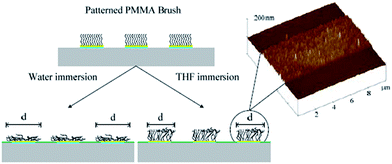 | ||
| Fig. 4 Schematic illustrations of reversible poly(methyl methacrylate) (PMMA) brush treated with good and poor solvents.60 | ||
Several other polymers such as poly-(ethylene glycol) (PEG), poly(butyl acrylate) and poly(2-dimethylaminoethyl methacrylate) have also been explored to fabricate solvent responsive polymers. Deformation of polymer brushes on solvent treatment has opened up many new possibilities in surface engineering concepts.62,63
2.1.3.1. Glucose responsive. Glucose responsive polymers are widely explored due to their potential applications in drug delivery (insulin delivery).64 Glucose responsive polymers are synthesized by conjugating glucose oxidase (GOx) with a pH responsive polymer. When such polymer comes in contact with glucose, GOx oxidizes glucose to gluconic acid which causes a change in pH of the environment. In response to the pH change, the pH responsive polymer shows a volume transition. This drastic change in the polymer is regulated by the body's glucose level which in turn affects the enzyme activity. Currently, there is huge amount of interest devoted in this area to develop sensitive, bio-degradable glucose responsive polymers.
2.1.3.2. Enzyme responsive. Naturally occurring bacteria located in the colon region secretes special enzymes such as azoreductase and glycosidases which are capable of degrading various polysaccharides including pectin, chitosan, dextrin etc.65–67 These bacterial enzymes generally destroy the polymer system completely. Henceforth, a typical enzyme responsive polymer system does not require any external trigger for its decomposition. Because of this mechanism, enzyme responsive polymers attract great deal of attention in biological applications. Nonetheless, a major challenge the researchers face in employing these polymer systems is the difficulty of precisely controlling the initial response time.68,69
2.2. Dual stimuli-responsive polymers
2.3. Multi stimuli-responsive polymers
The success of dual responsive polymers encouraged researchers to investigate and develop polymeric systems that can respond to triple stimuli. The addition of another stimulus with the dual responsive polymeric systems can improve the precision of the response. Furthermore, the presence of additional stimuli can also enhance the switching windows or switching conditions due to the increased level of polymer complexities.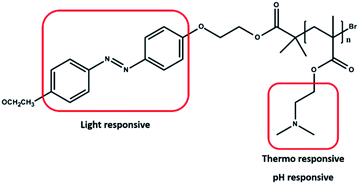 | ||
| Fig. 5 PDMAEMA polymer end-functionalized with azobenzene, which can be stimulated by light, temperature and change of the pH value.79 | ||
Recently, several other polymeric systems including PNIPAAM with spirobenzopyran, hyper-branched polyethylenimine with isobutyramide groups and copolymeric systems prepared using N-hydroxymethylacrylamide (NHMA), NIPAM and 2-diazo-1,2-naphthoquinone-5-sulfonylmethylacrylamide (DNQ) have also been investigated to produce triple responsive polymeric material systems.82
Though there are several other dual and multi stimuli responsive polymeric systems such as thermo-redox systems, environmental, pH and temperature responsive systems84,85 etc., the review within its scope has highlighted only the most widely used dual/multi stimuli systems.
3. Domain specific applications
Stimuli responsive polymers find their applications in numerous areas including sensors, actuators, biomedical and environmental applications. In this review article, we highlight few seminal applications of stimuli responsive polymeric systems.3.1. Sensors
Sensors are primarily used to sense and provide information when there is a change in either physical, chemical or biological changes in an environment. The sensed information is then used to trigger the necessary actions. Few examples include monitoring toxic gasses and vapours in the working environment; constant check on the contaminants level in the industrial effluents etc. Thus, novel developments in sensor technology will play a seminal role in maintaining a sustainable environment. As stimuli receptive polymers can sense and respond to the minor physical/chemical/biological changes, interest among the researchers has shifted to tailor make polymeric sensors. These sensors can address the needs of today's industrial demands to establish a sustainable environment.Stimuli responsive polymer surfaces can be used as a triggered “catch and release” surface for the fabrication of nanomaterials. Comrie et al.93 employed this property to fabricate polymer–metal micro objects. They achieved this by incorporating hydrophobic functional group into poly(glycidyl methacrylate) (PGMA) brushes as a means of creating a robust, etch resistant film on chromium substrate. This amalgamation of resistance to etching and ease of subsequent lift-off enabled the fabrication of hybrid planar polymer–metal objects. These types of responsive polymeric systems can be employed in areas such as drug delivery, biomimetic systems, MEMS (microelectromechanical systems) and NEMS (nanoelectromechanical systems).
In addition to PVC and PGMA, other polymeric materials such as PMMA,94 PNIPAAM95 have also been investigated to produce chemical sensors.
3.2. Actuators
Recently, researchers have employed stimuli responsive polymers to fabricate self-oscillating systems which can generate periodic mechanical energy from the chemical energy (Belousov–Zhabotinsky reaction). Such self-oscillating systems can be widely used in pulse generators, chemical pacemakers, actuators and micro-pumps.96 Yoshida et al.97 developed polymeric gels which can undergo peristaltic motion without the application of external stimuli. These unique polymeric gels are fabricated by co-polymerizing N-isopropylacrylamide (thermo responsive polymer), with ruthenium tris(2,20-bipyridine) [Ru(bpy)3] as the catalyst for the BZ reaction. Maeda et al.98 fabricated self-oscillating gel actuators with gradient structures. In this work, the pendulum motion is created by fixing one end of the gel as shown in Fig. 6. Aizenberg et al.99,100 produced thin hydrogel film actuators with high aspect ratio rods incorporated within them. The expansion and collapse of the thin hydrogel layers affected the orientation of the incorporated rods. These films can be employed in designing surfaces with reverse and conventional switching behaviour. | ||
| Fig. 6 Images of the repeated bending and stretching motion of the poly[NIPAAm-co-Ru(bpy)3-co-AMPS] gel strip (R10-A3) in the mixture solution of the BZ substrates; first, the whole gel strip was in homogeneous reduced state; second, the gel strip is in a locally oxidized state when the chemical wave propagates in the gel from one edge to the other edge (1 → 4); finally, the whole gel strip change reduced state, and was bending (5 → 6).98 | ||
Jager et al.101 fabricated micro-actuators based on polypyrrole–gold bilayers to enable large movement of structures attached to these actuators. They can be of great interest for the manipulation of biological objects such as single cells. Recently, Pedrosa and co-workers employed polypyrrole to fabricate polypyrrole–gold nanofingers which can effectively act as nano-actuators.102
3.3. Bio-medical applications
Uchiyama et al.103,104 employed PNIPAAM to detect the presence of benzofurazan and observed a clear reversible response to temperature cycles associated with PNIPAAM chain conformational changes and the polarity sensitivity of benzofurazan moieties. This behaviour is exemplified in Fig. 7 which clearly shows the change in the fluorescence intensity of the polymer at different temperatures. Several material systems including poly(2-vinylpyridine) (P2VP), diblock copolymers of poly(ethylene glycol) and poly(sulfadimethoxine) (PEG–PSDM) have also been explored for the fabrication of nano-biosensors in recent times.105–107
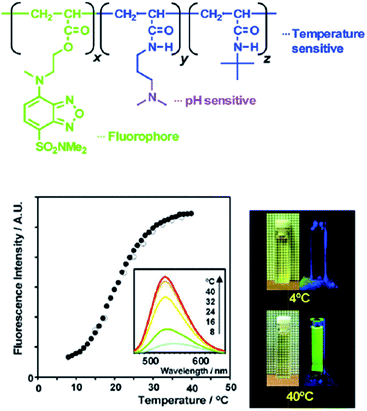 | ||
| Fig. 7 A Fluorescent polymer sensor for temperature.103 | ||
Lee et al.108 explored pluronic triblock copolymers [poly(ethylene oxide)–poly(propylene oxide)–poly(ethylene oxide) (PEO–PPO–PEO)] end-capped with a cyanine dye (Cy5.5) for imaging diseased tissues. Pluronic block copolymers responds to temperature stimulus via change in their supramolecular interactions. During heat treatment, polymer chains develop from a dissolved state to a micellar aggregation state. They found that the transition from dissolved chains to micelles is accompanied by fluorescence quenching of the Cy5.5 dye. These structures can be used as near infrared (NIR) thermo probes for imaging diseased/damaged tissues. In addition to block copolymers, poly(amidoamine) (PAMAM) dendrimers, peroxalate polymers embedded with fluorescent dye etc. have also been investigated for their potential use in imaging techniques.109,110
In addition to the above mentioned biomedical applications, stimuli responsive polymers have also been predominantly explored in the area of drug delivery systems including protein and enzyme delivery,111–118 gene delivery119–127 etc.
Thermo-responsive therapeutic grippers are widely used in drug delivery applications.128 Biopsy is another area which can make use of responsive polymers. Recently, Gultepe et al.129 fabricated thermally responsive untethered microtools (μ grippers) which can effectively replace the conventional biopsy forceps. Furthermore, research work have also been conducted on employing stimuli responsive polymers for other medical applications such as regenerative medicine, smart surfaces for tissue engineering, fabrication of biological interfaces, injectable implants130–145 etc. Table 1 summarizes the classes of polymer systems that are used for various stimuli responsive applications.
| S. no | Types of stimuli | Responsive polymers/co-polymers | Applications |
|---|---|---|---|
| 1 | Physical | PNIPAAM, PDMAEMA, PEGMA, PCLDIMA, azobenzene, spiropyran | Sensors, actuators, switchable wettability, self-healing, anti-fouling |
| 2 | Chemical | Chitosan, albumin, gelatin PDAAEMA, PAAc, PEI | |
| 3 | Biological | Chitosan, polycaprolactone, PLA, PLGA | Diagnosis, imaging, drug delivery, bio-interface, biopsy studies |
4. A new-route towards sustainable environment
In today's world, environmental contamination is increasing drastically due to urbanization, increased industrial effluence and constant change in the life style of people. As a result of this, there is a substantial increase in global warming causing ad hoc changes in the climatic conditions throughout the world. According to the recent report from NASA, the rate of increase of earth temperature has nearly doubled in the last 50 years.146 In current scenario, providing clean air to breathe and pure drinking water for the world population itself poses immense challenge.147 Nonetheless, the advent of new-age smart, functional polymeric materials has given enormous hope, scope and opportunities to establish a sustainable environment. Though, the stimuli responsive polymeric materials may not provide solution for all the environmental issues, they can still address vital issues like reduction of sewage fouling, seawater fouling, fouling caused by industrial effluents and automobile exhaust etc.Furthermore, the ability of stimuli responsive polymeric materials to absorb moisture from the humid environment and release pure water on application of suitable stimuli has made them a potential candidate to address the growing demand for the supply of pure water in the humid geographical locations. Due to their diversified abilities, researchers believe that stimuli responsive polymeric materials can provide much needed remedy to the growing demands of today's environment. Henceforth, many research groups have focused their attention on developing polymeric systems for anti-fouling and water harvesting applications. The following two sections of the review article highlights some seminal research work that has been reported so far in the literature that employs stimuli responsive polymeric materials for anti-fouling and water harvesting applications.
4.1. Water harvesting
The very idea of harvesting water from the moist environment has been derived from nature. This behaviour of extracting water from humid air was first observed in a special type of desert beetle known as Stenocara (the tenebrionid beetle, Fig. 8a). This insect possesses a tailor made covering on its body for collecting water from early morning fog.148 The beetle tilts its body forward into the direction of blowing winds and makes use of its tailor made carapace to extract water from air. It is believed that the large droplet of water is deposited on its carapace due to the insect's bumpy surface (near-random array of bumps 0.5–1.5 mm apart, each about 0.5 mm in diameter, Fig. 8b) which consist of alternating hydrophobic (waxy region) and hydrophilic (non-waxy) regions. The water harvesting system functions by ‘growing’ droplets on the hydrophilic seeding points of the peaks. The water present in the fog/moisture settles on these hydrophilic peaks gets accumulated to from large droplets of water. The water striking the hydrophobic slopes bounces towards hydrophilic region and gets collected.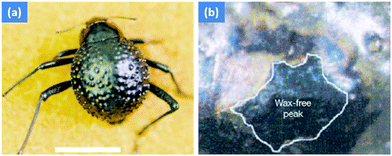 | ||
| Fig. 8 The water-capturing surface of the fused over-wings (elytra) of the desert beetle Stenocara. (a) Adult female, dorsal view; peaks and troughs are evident on the surface of the elytra; (b) a ‘bump’ on the elytra, stained with Red O for 15 min and then with 60% isopropanol for 10 min, a procedure that tests for waxes. Depressed areas of the otherwise black elytra are stained positively (waxy, colored), whereas the peaks of the bumps remain unstained (wax-free; black).148 | ||
In addition to dessert beetles, Zheng et al.149 investigated and reported that spider silk also possesses the ability to extract water from moist air. Water harvesting ability of cribellate ‘Uloborus walckenaerius’ spider's silk is attributed to the unique fiber structure that it attains after it comes in contact with moisture. The ‘wet-rebuilt’ fibers are characterized by periodic spindle-knots made of random nanofibrils and separated by joints made of aligned nanofibrils (Fig. 9). These unique structural features result in a surface energy gradient between the spindle-knots and the joints and also in a difference in Laplace pressure, with both factors acting together to achieve continuous condensation and directional collection of water drops around spindle-knots. In this way, the spider silk harvest water from the humid air.
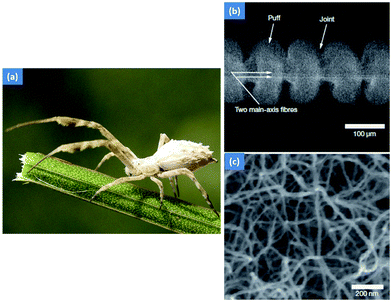 | ||
| Fig. 9 Photograph of Uloborus walckenaerius (photo credit: Ferran Turmo Gort; authors would like to convey special thanks to Ferran Turmo Gort for the photograph); (b) low magnification environmental SEM image of periodic puffs and joints surrounding two main-axis fibers; (c) magnified image of puff composed of countless nanofibrils.149 | ||
Inspired by these water harvesting strategies perfected by nature, over the past decade, researchers have investigated techniques to mimic the biological approach with the help of synthetic materials to develop an efficient water harvesting systems that are capable of extracting water from foggy/moist environment. Recently, Yang et al.150 employed “grafting form” approach to fabricate sponge-like cotton fabric using poly(N-isopropylacrylamide), PNIPAAM, brushes which has the ability to autonomously collect and release water from humid atmosphere (Fig. 10). In this polymeric system, the collection and release of water from fog/moisture is triggered and controlled by applied temperature. The mechanism behind this phenomenon is attributed to the structural changes of temperature responsive PNIPAAM combined with the high surface roughness of the synthesized fabric. This mechanism is also responsible for reversible switching between two extreme wettability states (superhydrophilicity/superhydrophobicity) (see Fig. 11). Lot of research work is being carried out in this area using various stimuli responsive polymeric systems.151–155
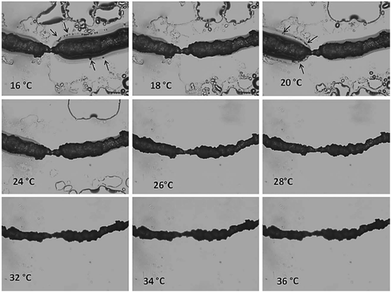 | ||
| Fig. 10 Water collection/release by the PNIPAAM-cotton fiber upon temperature changes. OM sequential images of the PNIPAAM-cotton as the temperature rises from 16–36 °C under controlled atmosphere (96% humidity). Arrows indicate water droplets absorbed by the fiber.150 | ||
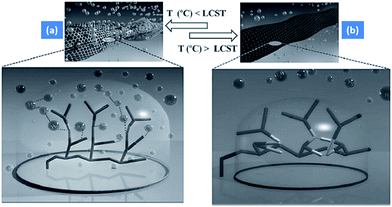 | ||
| Fig. 11 (a) water collection (superhydrophilic state) by hydrogen bonding between PNIPAAM; (b) water release (superhydrophobic state) by the formation of PNIPAAM intermolecular bonds.150 | ||
4.2. Anti-fouling
Currently, anti-fouling is another critical environmental application in which stimuli responsive polymers are widely explored. In particular, poly(N-isopropylacrylamide) (PNIPAAM) is most widely studied environmentally sensitive polymer for anti-fouling applications.156–163 Lopez et al.156 investigated the stimuli responsive wettability of PNIPAAM for anti-fouling applications (fouling-release surfaces). They employed dip coating approach to fabricate anti-fouling coatings on glass substrates. PNIPAAM-coated glass slides were subjected to incubation (18 h) in artificial sea water containing the marine bacterium Halomonas marina or in natural bay water at a temperature above the LCST. The samples were then rinsed with artificial seawater (4 °C) to induce fouling release properties. The authors report that 95% of the fouling bacterial cells that had attached to the PNIPAAM surfaces were removed effectively. Lopez and co-workers157 also studied the anti-fouling abilities of surfaces fabricated from PNIPAAM-PS (polystyrene) tethered surfaces. Furthermore, the same research group prepared anti-fouling films on gold surfaces by in situ polymerization of NIPAAM on initiator modified self-assembled monolayers (SAM) (Fig. 12).158 From the attachment and detachment studies, it is seen that more than 90% of cells are released from PNIPAAM functionalized SAM surface.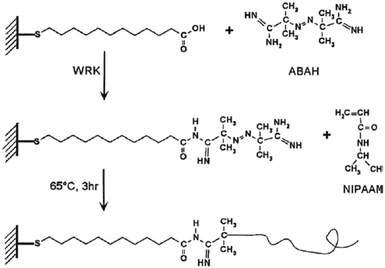 | ||
| Fig. 12 Schematic representation of the process of in situ polymerization of NIPAAM on initiator-derivatized SAMs. 2,2′-Azobis(2-amidopropane) hydrochloride (ABAH) is used as a free-radical initiator; NIPAAM = N-isopropylacrylamide.158 | ||
In addition to PNIPAAM, poly(ethylene oxide) PEO is also explored for anti-fouling properties. Recently, Minko et al.164 proposed a novel coating approach with 3D grafted polymer structure for rendering a surface with long-lasting antifouling properties (Fig. 13).
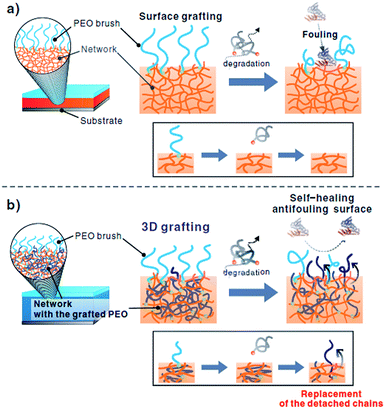 | ||
| Fig. 13 Schematic illustration of the PEO-grafted P2VP network films: (a) the grafting of PEO to the surface of a P2VP film and (b) 3D polymer grafting on the surface and inside of a P2VP film. The self-healing aspect of the antifouling property is due to the rearrangement of internally grafted polymers to the interface (marked as dark blue chains).164 | ||
The proposed coating with the 3D grafting consisting of polymeric chains grafted both to the surface and inside the host material possesses the ability to retain the anti-fouling effect even when substantial fraction of the grafted polymers are degraded and detached. The self-healing mechanism of the proposed structure refers to the replacement of the detached or damaged polymeric chains by segments of the chains stored inside the film in proximity to the interface. A number of segments of the stored grafted chains relocate from the film's interior driven by an emerging gradient in a chemical potential, and an antifouling effect in the exposed area can thus be recovered by itself. The authors claim that the pH-responsive poly(2-vinylpyridine) films with the 3D grafting of poly(ethylene oxide) in physiological conditions (pH 7.4 and 37 °C) demonstrated a 4-fold increase in longevity of antifouling behaviour than the material with the surface grafted polymer. Furthermore, it was observed that, the 3D grafted responsive films retain their pH responsive properties.
5. Conclusions and future outlook
In the recent past, stimuli responsive polymers/polymeric composites have attracted great deal of attention due to their innumerable applications including sensors, actuators, switchable wettability, drug delivery, imaging, diagnosis, self-healing coatings and also in miniaturized electronic devices. The rapid development in this field is due to (1) comprehensive understanding of the responsive polymeric moieties interaction; (2) development of new erudite synthesising approaches; (3) fabrication of polymeric systems which can be controlled by employing more than one stimuli and (4) nanoscale fabrication of stimuli responsive surfaces etc. Future studies can focus on doping stimuli responsive polymeric materials with metal oxide and noble metal nano-particles. Incorporation of these dopants into the polymeric matrix may result in interesting properties.In yet another example, stimuli responsive polymers can potentially play a major role for development in the field of information technology. The concept of orthogonal and independent addressing of the responsive group may result in achieving parallel writing of information. Furthermore, a dramatic increase in memory density may also be possible in future. These objectives can be achieved by the development of new polymer chemistries and also by the precise control of several stimuli responsive groups. Medical application is another field, which is expected to be impacted by the developments in stimuli responsive polymers. Though abundant research has been carried out in employing stimuli responsive polymers in various medical applications including diagnostic equipment, therapeutic treatments, tissue regeneration etc., application of stimuli responsive materials at nanometre scale is still an emerging area which will benefit greatly from extensive studies on bio-disposability, bio-distribution, toxicity etc. Another area that is gaining huge amount of interest is the development of CO2 responsive polymers. Certain CO2 responsive polymers can reversibly capture CO2 from air resulting in the reduction of greenhouse effect. However, further extensive studies are needed to address the existing challenges in the area of CO2 responsive polymers including the development of facile synthetic approaches, exploring the behaviour of CO2 responsive polymers by modifying the physical properties such as shape and size etc.
Recently, numerous studies have explored the feasibility of employing stimuli responsive polymeric materials in anti-fouling and water harvesting applications. In future, commercial success of stimuli responsive materials in anti-fouling and water harvesting applications may lead to establishing a sustainable environment. Above all, we believe that fabrication of cost effective and highly efficient stimuli responsive materials for household, industrial, medicinal and environmental applications may require successful collaboration among researchers from different fields, so that in near future, stimuli responsive materials may pave the way for a better tomorrow.
Acknowledgements
The authors, VAG and AB would like to acknowledge the financial support from Ministry of Education (MOE – Tier 2), Singapore [Grant T2-MOE-1302]. AB also acknowledges the financial support of SUTD start-up grant (SRG EPD 2013 055).References
- L. Zhai, Chem. Soc. Rev., 2013, 42, 7148–7160 RSC.
- J. R. Capadona, K. Shanmuganathan, D. J. Tyler, S. J. Rowan and C. Weder, Science, 2008, 319, 1370–1374 CrossRef CAS PubMed; R. Birenheide, M. Tamori, T. Motokawa, M. Ohtani, E. Iwakoshi, Y. Muneoka, T. Fujita, H. Minakata and K. Nomoto, Biol. Bull., 1998, 194, 253–259 CrossRef PubMed.
- Handbook of Stimuli-Responsive Materials, ed. U. Marek, Wiley-VCH Verlag GmbH&Co. KGaA, Weinheim, Germany, 2011 Search PubMed.
- L. Brunsveld, B. J. B. Folmer, E. W. Meijer and R. P. Sijbesma, Chem. Rev., 2001, 101, 4071–4098 CrossRef CAS PubMed.
- D. Roy, J. N. Cambre and B. S. Sumerlin, Prog. Polym. Sci., 2010, 35, 278–301 CrossRef CAS.
- F. Liu and M. W. Urban, Prog. Polym. Sci., 2010, 35, 3–23 CrossRef CAS.
- M. A. C. Stuart, W. T. S. Huck, J. Genzer, M. Muller, C. Ober, M. Stamm, G. B. Sukhorukov, I. Szleifer, V. V. Tsukruk, M. Urban, F. Winnik, S. Zauscher, I. Luzinov and S. Minko, Nat. Mater., 2010, 9, 101–113 CrossRef PubMed.
- E. Cabane, X. Zhang, K. Langowska, C. G. Palivan and W. Meier, Biointerphases, 2012, 7(1–4), 9 CAS.
- E. S. Gil and S. M. Hudson, Prog. Polym. Sci., 2004, 29, 1173–1222 CrossRef CAS.
- M. Delcea, H. Mohwald and A. G. Skirtach, Adv. Drug Delivery Rev., 2011, 63, 730–747 CrossRef CAS PubMed.
- W. B. Liechty, D. R. Kryscio, B. V. Slaughter and N. A. Peppas, Annu. Rev. Chem. Biomol. Eng., 2010, 1, 149–173 CrossRef CAS PubMed.
- N. Zhang, S. Salzinger and B. Rieger, Macromolecules, 2012, 45, 9751–9758 CrossRef CAS.
- X. Y. Liu, F. Cheng, Y. Liu, H. J. Liu and Y. Chen, J. Mater. Chem., 2010, 20, 360–368 RSC.
- B. Xue, L. Gao, Y. Hou, Z. Liu and L. Jiang, Adv. Mater., 2013, 25, 273–277 CrossRef CAS PubMed.
- Y. Liu, L. Meng, X. Lu, L. Zhang and Y. He, Polym. Adv. Technol., 2008, 19, 137–143 CrossRef CAS.
- S. Ohya, H. Sonoda, Y. Nakayama and T. Matsuda, Biomaterials, 2005, 26, 655–659 CrossRef CAS PubMed.
- K. Suwa, K. Morishita, A. Kishida and M. Akashi, J. Polym. Sci., Part A: Polym. Chem., 1997, 35, 3087–3094 CrossRef CAS.
- K. Na, K. H. Lee, D. H. Lee and Y. H. Bae, Eur. J. Pharm. Sci., 2006, 27, 115–122 CrossRef CAS PubMed.
- A. Sosnik and D. Cohn, Biomaterials, 2004, 25, 2851–2858 CrossRef CAS PubMed.
- Y. Qiu and K. Park, Adv. Drug Delivery Rev., 2001, 53, 321–339 CrossRef CAS PubMed.
- A. Roggan, M. Friebel, K. Dorschel, A. Hahn and G. Muller, J. Biomed. Opt., 1999, 4, 36–46 CrossRef CAS PubMed.
- Y. Shiraishi, R. Miyamoto and T. Hirai, Org. Lett., 2009, 11, 1571–1574 CrossRef CAS PubMed.
- A. Albini, E. Fasani and D. Faiardi, J. Org. Chem., 1987, 52, 155–157 CrossRef CAS.
- F. D. Jochum and P. Theato, Polymer, 2009, 50, 3079–3085 CrossRef CAS.
- Z. Mahimwalla, K. Yager, J. Mamiya, A. Shishido, A. Priimagi and C. Barrett, Polym. Bull., 2012, 69, 967–1006 CrossRef CAS.
- C. Pietsch, U. S. Schubert and R. Hoogenboom, Chem. Commun., 2011, 8750–8765 RSC.
- T. Hirakura, Y. Nomura, Y. Aoyama and K. Akiyoshi, Biomacromolecules, 2004, 5, 1804–1809 CrossRef CAS PubMed.
- M. Rini, A. K. Holm, E. T. J. Nibbering and H. Fidder, J. Am. Chem. Soc., 2003, 125, 3028–3034 CrossRef CAS PubMed.
- Y. Huang, W. Liang, J. K. S. Poon, Y. Xu, R. K. Lee and A. Yariv, Appl. Phys. Lett., 2006, 88, 181102–181103 CrossRef.
- A. K. Chibisov and H. Gorner, Phys. Chem. Chem. Phys., 2001, 3, 424–431 RSC.
- Y. Zhao, J. Mater. Chem., 2009, 19, 4887–4895 RSC.
- P. M. Mendes, Chem. Soc. Rev., 2008, 37, 2512–2529 RSC.
- D. P. Jones, J. L. Carlson, P. S. Samiec, P. Sternberg, V. C. Mody, R. L. Reed and L. A. S. Brown, Clin. Chim. Acta, 1998, 275, 175–184 CrossRef CAS.
- A. N. Koo, H. J. Lee, S. E. Kim, J. H. Chang, C. Park, C. Kim, J. H. Park and S. C. Lee, Chem. Commun., 2008, 44, 6570–6572 RSC.
- X. Yu, S. Zhou, X. Zheng, T. Guo, Y. Xiao and B. Song, Nanotechnology, 2009, 20(235702), 1–9 Search PubMed.
- J. M. Cuevas, J. Alonso, L. German, M. Iturrondobeitia, J. M. Laza and J. L. Vilas, Smart Mater. Struct., 2009, 18(075003), 1–10 Search PubMed.
- A. Golbang and M. Kokabi, Eur. Polym. J., 2011, 47, 1709–1719 CrossRef CAS.
- M. Zeng, S. W. Or and H. L. W. Chan, J. Appl. Phys., 2010, 96(203502), 1–3 Search PubMed.
- D. W. Zhang, Y. J. Liu and J. S. Leng, Appl. Phys. Lett., 2010, 96(111905), 1–3 CrossRef.
- Z. Varga, G. Filipcsei and M. Zrinyi, Polymer, 2006, 47, 227–233 CrossRef CAS.
- S. P. Nunes, A. R. Behzad, B. Hooghan, R. Sougrat, M. Karunakaran, N. Pradeep, U. Vainio and K. V. Peinemann, ACS Nano, 2011, 5, 3516–3522 CrossRef CAS PubMed.
- H. Jia, A. Wildes and S. Titmuss, Macromolecules, 2012, 45, 305–312 CrossRef CAS.
- R. Liu, P. Liao, J. Liu and P. Feng, Langmuir, 2011, 27, 3095–3099 CrossRef CAS PubMed.
- S. Dai, P. Ravi and K. C. Tam, Soft Matter, 2008, 4, 435–449 RSC.
- F. Liu and M. W. Urban, Macromolecules, 2008, 41, 6531–6539 CrossRef CAS.
- M. Y. Abdelaal, E. A. Abdel-Razik, E. M. Abdel-Bary and I. M. Sherbiny, J. Appl. Polym. Sci., 2007, 103, 2864–2874 CrossRef CAS.
- H. Y. Park, I. H. Song, J. H. Kim and W. S. Kim, Int. J. Pharm., 1998, 175, 231–236 CrossRef CAS.
- M. Kurisawa and N. Yui, Macromol. Chem. Phys., 1998, 199, 1547–1554 CrossRef CAS.
- J. W. Lee, S. Y. Kim, S. S. Kim, Y. M. Lee, K. H. Lee and S. J. Kim, J. Appl. Polym. Sci., 1999, 73, 113–120 CrossRef CAS.
- J. Zhang and N. A. Peppas, Macromolecules, 1999, 33, 102–107 CrossRef.
- Z. Sideratou, D. Tsiourvas and C. M. Paleos, Langmuir, 2000, 16, 1766–1769 CrossRef CAS.
- S. E. Burke and C. J. Barrett, Biomacromolecules, 2003, 4, 1773–1783 CrossRef CAS PubMed.
- V. Toncheva, M. A. Wolfert, P. R. Dash, D. Oupicky, K. Ulbrich and L. W. Seymour, Biochim. Biophys. Acta, 1998, 1380, 354–368 CrossRef CAS.
- H. Logtenberg and W. R. Browne, Org. Biomol. Chem., 2013, 11, 233–243 CAS.
- M. Mazurowski, M. Gallei, J. Li, H. Didzoleit, B. Stuhn and M. Rehahn, Macromolecules, 2012, 45, 8970–8981 CrossRef CAS.
- D. J. Phillips and M. I. Gibson, Chem. Commun., 2012, 48, 1054–1056 RSC.
- K. W. Leong, B. C. Brott and R. Langer, J. Biomed. Mater. Res., 1985, 19, 941–955 CrossRef CAS PubMed.
- S. Cohen, T. Yoshioka, M. Lucarelli, L. H. Hwang and R. Langer, Pharm. Res., 1991, 8, 713–720 CrossRef CAS.
- R. Yoshida, T. Yamaguchi and E. Kokufuta, J. Artif. Organs, 1999, 2, 135–140 CrossRef CAS.
- J. K. Chen, C. Y. Hsieh, C. F. Huang, P. M. Li, S. W. Kuo and F. C. Chang, Macromolecules, 2008, 41, 8729–8736 CrossRef CAS.
- J. K. Chen, C. Y. Hsieh, C. F. Huang and P. M. Li, J. Colloid Interface Sci., 2009, 338, 428–434 CrossRef CAS PubMed.
- J. K. Chen and A. L. Zhuang, J. Phys. Chem. C, 2010, 114, 11801–11809 CAS.
- J. K. Chen and A. L. Zhuang, Colloid Polym. Sci., 2011, 289, 1283–1294 CAS.
- S. Cerritelli, D. Velluto and J. A. Hubbell, Biomacromolecules, 2007, 8, 1966–1972 CrossRef CAS PubMed.
- O. Chambin, G. Dupuis, D. Champion, A. Voilley and Y. Pourcelot, Int. J. Pharm., 2006, 321, 86–93 CrossRef CAS PubMed.
- V. R. Sinha and R. Kumria, Int. J. Pharm., 2001, 224, 19–38 CrossRef CAS PubMed.
- T. F. Vandamme, A. Lenourry, C. Charrueau and J. C. Chaumeil, Carbohydr. Polym., 2002, 48, 219–231 CrossRef CAS.
- Y. Itoh, M. Matsusaki, T. Kida and M. Akashi, Biomacromolecules, 2006, 7, 2715–2718 CrossRef CAS PubMed.
- E. O. Akala, P. Kopeckova and J. Kopecek, Biomaterials, 1998, 19, 1037–1047 CrossRef CAS PubMed.
- D. Kungwatchakun and M. Irie, Makromol. Chem., Rapid Commun., 1988, 9, 243–246 CrossRef CAS.
- X. Tao, Z. Gao, T. Satoh, Y. Cui, T. Kakuchi and Q. Duan, Polym. Chem., 2011, 2, 2068–2073 RSC.
- A. Dirani, X. Laloyaux, A. E. Fernandes, B. Mathy, O. Schicke, O. Riant, B. Nysten and A. M. Jonas, Macromolecules, 2012, 45, 9400–9408 CrossRef CAS.
- F. D. Jochum, L. Zur Borg, P. J. Roth and P. Theato, Macromolecules, 2009, 42, 7854–7862 CrossRef CAS.
- N. Ishii, J. Mamiya, T. Ikeda and F. M. Winnik, Chem. Commun., 2011, 47, 1267–1269 RSC.
- B. Mu and P. Liu, React. Funct. Polym., 2012, 72, 983–989 CrossRef CAS.
- C. M. Schilli, M. Zhang, E. Rizzardo, S. H. Thang, Y. K. Chong, K. Edwards, G. Karlsson and A. H. E. Muller, Macromolecules, 2004, 37, 7861–7866 CrossRef CAS.
- S. Kulkarni, C. Schilli, B. Grin, A. H. E. Muller, A. S. Hoffman and P. S. Stayton, Biomacromolecules, 2006, 7, 2736–2741 CrossRef CAS PubMed.
- V. Butun, S. P. Armes and N. C. Billingham, Polymer, 2001, 42, 5993–6008 CrossRef CAS.
- X. Tang, X. Liang, L. Gao, X. Fan and Q. Zhou, J. Polym. Sci., Part A: Polym. Chem., 2010, 48, 2564–2570 CrossRef CAS.
- H. Akiyama and N. Tamaoki, Macromolecules, 2007, 40, 5129–5132 CrossRef CAS.
- H. Akiyama and N. Tamaoki, J. Polym. Sci., Part A: Polym. Chem., 2004, 42, 5200–5214 CrossRef CAS.
- Y. Y. Yu, F. Tian, C. Wei and C. C. Wang, J. Polym. Sci., Part A: Polym. Chem., 2009, 47, 2763–2773 CrossRef CAS.
- P. Schattling, F. D. Jochum and P. Theato, Chem. Commun., 2011, 47, 8859–8861 RSC.
- D. J. Phillips and M. I. Gibson, Biomacromolecules, 2012, 13, 3200–3208 CrossRef CAS PubMed.
- N. Kuramoto, Y. Shishido and K. Nagai, J. Polym. Sci., Part A: Polym. Chem., 1997, 35, 1967–1972 CrossRef CAS.
- J. K. Chen, J. H. Wang, C. C. Cheng and J. Y. Chang, ACS Appl. Mater. Interfaces, 2013, 5, 2959–2966 CAS.
- J. K. Chen, J. H. Wang, C. C. Cheng, J. W. Chang and F. C. Chang, Appl. Phys. Lett., 2013, 102(151906), 1–4 Search PubMed.
- J. K. Chen and B. J. Bai, J. Phys. Chem. C, 2011, 115, 21341–21350 CAS.
- J. H. Chen, J. H. Wang, C. J. Chang and C. F. Huang, Sens. Actuators, B, 2013, 188, 1123–1131 CrossRef CAS.
- K. Matsubara, M. Watanabe and Y. Takeoka, Angew. Chem., Int. Ed., 2007, 46, 1688–1692 CrossRef CAS PubMed.
- N. A. El-Ragehy, A. M. El-Kosasy, S. S. Abbas and S. Z. El-Khateeb, Anal. Chim. Acta, 2000, 418, 93–100 CrossRef CAS.
- Z. H. Liu, M. L. Wen, Y. Yao and J. Xiong, Sens. Actuators, B, 2001, 77, 219–223 CrossRef.
- J. E. Comrie and W. T. S. Huck, Langmuir, 2007, 23, 1569–1576 CrossRef CAS PubMed.
- S. Tugulu, M. Harms, M. Fricke, D. Volkmer and H. A. Klok, Angew. Chem., Int. Ed., 2006, 45, 7458–7461 CrossRef CAS PubMed.
- S. Y. Kim, T. Kanamori and T. Shinbo, J. Appl. Polym. Sci., 2002, 84, 1168–1177 CrossRef CAS.
- A. N. Zaikin and A. M. Zhabotinsky, Nature, 1970, 225, 535–537 CrossRef CAS PubMed.
- Y. Murase, S. Maeda, S. Hashimoto and R. Yoshida, Langmuir, 2009, 25, 483–489 CrossRef CAS PubMed.
- S. Maeda, Y. Hara, R. Yoshida and S. Hashimoto, Macromol. Rapid Commun., 2008, 29, 401–405 CrossRef CAS.
- B. Pokroy, A. K. Epstein, M. C. M. Persson-Gulda and J. Aizenberg, Adv. Mater., 2009, 21, 463–469 CrossRef CAS.
- A. Sidorenko, T. Krupenkin, A. Taylor, P. Fratzl and J. Aizenberg, Science, 2007, 315, 487–490 CrossRef CAS PubMed.
- E. W. H. Jager, O. Inganäs and I. Lundström, Science, 2000, 288, 2335–2338 CrossRef CAS PubMed.
- V. A. Pedrosa, X. Luo, J. Burdick and J. Wang, Small, 2008, 4, 738–741 CrossRef CAS PubMed.
- S. Uchiyama, N. Kawai, A. P. de Silva and K. Iwai, J. Am. Chem. Soc., 2004, 126, 3032–3033 CrossRef CAS PubMed.
- S. Uchiyama, Y. Matsumura, A. P. de Silva and K. Iwai, Anal. Chem., 2003, 75, 5926–5935 CrossRef CAS PubMed.
- I. Tokareva, S. Minko, J. H. Fendler and E. Hutter, J. Am. Chem. Soc., 2004, 126, 15950–15951 CrossRef CAS PubMed.
- S. W. Hong, C. H. Ahn, J. Huh and W. H. Jo, Macromolecules, 2006, 39, 7694–7700 CrossRef CAS.
- T. Wu, G. Zou, J. Hu and S. Liu, Chem. Mater., 2009, 21, 3788–3798 CrossRef CAS.
- S. Y. Lee, S. Lee, I. C. Youn, D. K. Yi, Y. T. Lim, B. H. Chung, J. F. Leary, I. C. Kwon, K. Kim and K. Choi, Chem.–Eur. J., 2009, 15, 6103–6106 CrossRef CAS PubMed.
- J. M. Criscione, B. L. Le, E. Stern, M. Brennan, C. Rahner, X. Papademetris and T. M. Fahmy, Biomaterials, 2009, 30, 3946–3955 CrossRef CAS PubMed.
- D. Lee, S. Khaja, J. C. Velasquez-Castano, M. Dasari, C. Sun, J. Petros, W. R. Taylor and N. Murthy, Nat. Mater., 2007, 6, 765–769 CrossRef CAS PubMed.
- E. Cabane, V. Malinova, S. Menon, C. G. Palivan and W. Meier, Soft Matter, 2011, 7, 9167–9176 RSC.
- J. C. M. Lee, H. Bermudez, B. M. Discher, M. A. Sheehan, Y. Y. Won, F. S. Bates and D. E. Discher, Biotechnol. Bioeng., 2001, 73, 135–145 CrossRef CAS PubMed.
- Y. Lee and K. Kataoka, Soft Matter, 2009, 5, 3810–3817 RSC.
- Y. Lee, S. Fukushima, Y. Bae, S. Hiki, T. Ishii and K. Kataoka, J. Am. Chem. Soc., 2007, 129, 5362–5363 CrossRef CAS PubMed.
- P. M. George, D. A. LaVan, J. A. Burdick, C. Y. Chen, E. Liang and R. Langer, Adv. Mater., 2006, 18, 577–581 CrossRef CAS.
- J. M. Pernaut and J. R. Reynolds, J. Phys. Chem. B, 2000, 104, 4080–4090 CrossRef CAS.
- M. S. Yavuz, Y. Cheng, J. Chen, C. M. Cobley, Q. Zhang, M. Rycenga, J. Xie, C. Kim, K. H. Song, A. G. Schwartz, L. V. Wang and Y. Xia, Nat. Mater., 2009, 8, 935–939 CrossRef CAS PubMed.
- C. T. Huynh, S. W. Kang, Y. Li, B. S. Kim and D. S. Lee, Soft Matter, 2011, 7, 8984–8990 RSC.
- D. Wakebayashi, N. Nishiyama, Y. Yamasaki, K. Itaka, N. Kanayama, A. Harada, Y. Nagasaki and K. Kataoka, J. Controlled Release, 2004, 95, 653–664 CrossRef CAS PubMed.
- X. B. Xiong, H. Uludag and A. Lavasanifar, Biomaterials, 2010, 31, 5886–5893 CrossRef CAS PubMed.
- S. Lin, F. Du, Y. Wang, S. Ji, D. Liang, L. Yu and Z. Li, Biomacromolecules, 2007, 9, 109–115 CrossRef PubMed.
- J. Du, Y. Tang, A. L. Lewis and S. P. Armes, J. Am. Chem. Soc., 2005, 127, 17982–17983 CrossRef CAS PubMed.
- H. Lomas, I. Canton, S. MacNeil, J. Du, S. P. Armes, A. J. Ryan, A. L. Lewis and G. Battaglia, Adv. Mater., 2007, 19, 4238–4243 CrossRef CAS.
- H. Lomas, M. Massignani, K. A. Abdullah, I. Canton, C. Lo Presti, S. MacNeil, J. Du, A. Blanazs, J. Madsen, S. P. Armes, A. L. Lewis and G. Battaglia, Faraday Discuss., 2008, 139, 143–159 RSC.
- H. Iatrou, H. Frielinghaus, S. Hanski, N. Ferderigos, J. Ruokolainen, O. Ikkala, D. Richter, J. Mays and N. Hadjichristidis, Biomacromolecules, 2007, 8, 2173–2181 CrossRef CAS PubMed.
- M. Oishi, S. Sasaki, Y. Nagasaki and K. Kataoka, Biomacromolecules, 2003, 4, 1426–1432 CrossRef CAS PubMed.
- N. K. Jain and A. Asthana, Expert Opin. Drug Delivery, 2007, 4, 495–512 CrossRef CAS PubMed.
- K. Malachowski, J. Breger, H. R. Kwag, M. O. Wang, J. P. Fisher, F. M. Selaru and D. H. Gracias, Angew. Chem., Int. Ed., 2014, 53, 8045–8049 CrossRef CAS PubMed.
- E. Gultepe, J. S. Randhawa, S. Kadam, S. Yamanaka, F. M. Selaru, E. J. Shin, A. N. Kalloo and D. H. Gracias, Adv. Mater., 2013, 25, 514–519 CrossRef CAS PubMed.
- A. Kushida, M. Yamato, C. Konno, A. Kikuchi, Y. Sakurai and T. Okano, J. Biomed. Mater. Res., 1999, 45, 355–362 CrossRef CAS PubMed.
- M. Hirose, O. H. Kwon, M. Yamato, A. Kikuchi and T. Okano, Biomacromolecules, 2000, 1, 377–381 CrossRef CAS PubMed.
- M. Yamato, C. Konno, M. Utsumi, A. Kikuchi and T. Okano, Biomaterials, 2002, 23, 561–567 CrossRef CAS PubMed.
- M. Ebara, M. Yamato, T. Aoyagi, A. Kikuchi, K. Sakai and T. Okano, Biomacromolecules, 2004, 5, 505–510 CrossRef CAS PubMed.
- K. Anikin, C. Rocker, A. Wittemann, J. Wiedenmann, M. Ballauff and G. U. Nienhaus, J. Phys. Chem. B, 2005, 109, 5418–5420 CrossRef CAS PubMed.
- N. Nath and A. Chilkoti, Anal. Chem., 2003, 75, 709–715 CrossRef CAS PubMed.
- N. Comolli, B. Neuhuber, I. Fischer and A. Lowman, Acta Biomater., 2009, 5, 1046–1055 CrossRef CAS PubMed.
- S. Y. Kim and S. C. Lee, J. Appl. Polym. Sci., 2009, 113, 3460–3469 CrossRef CAS.
- W. Frey, D. E. Meyer and A. Chilkoti, Langmuir, 2003, 19, 1641–1653 CrossRef CAS.
- J. Hyun, W. K. Lee, N. Nath, A. Chilkoti and S. Zauscher, J. Am. Chem. Soc., 2004, 126, 7330–7335 CrossRef CAS PubMed.
- D. Cunliffe, C. de las Heras Alarcon, V. Peters, J. R. Smith and C. Alexander, Langmuir, 2003, 19, 2888–2899 CrossRef CAS.
- C. E. Schmidt, V. R. Shastri, J. P. Vacanti and R. Langer, Proc. Natl. Acad. Sci. U. S. A., 1997, 94, 8948–8953 CrossRef CAS.
- J. Shi, N. M. Alves and J. F. Mano, Adv. Funct. Mater., 2007, 17, 3312–3318 CrossRef CAS.
- J. H. Cho, S. H. Kim, K. D. Park, M. C. Jung, W. I. Yang, S. W. Han, J. Y. Noh and J. W. Lee, Biomaterials, 2004, 25, 5743–5751 CrossRef CAS PubMed.
- J. P. Chen and T. H. Cheng, Macromol. Biosci., 2006, 6, 1026–1039 CrossRef CAS PubMed.
- J. H. Ryu, Y. Lee, W. H. Kong, T. G. Kim, T. G. Park and H. Lee, Biomacromolecules, 2011, 12, 2653–2659 CrossRef CAS PubMed.
- http://earthobservatory.nasa.gov/Features/GlobalWarming.
- M. A. Montgomery and M. Elimelech, Environ. Sci. Technol., 2007, 41, 17–24 CrossRef PubMed.
- A. R. Parker and C. Lawrence, Nature, 2001, 414, 33–34 CrossRef CAS PubMed.
- Y. Zheng, H. Bai, Z. Huang, X. Tian, F. Q. Nie, Y. Zhao, J. Zhai1 and L. Jiang, Nature, 2010, 463, 640–643 CrossRef CAS PubMed.
- H. Yang, H. Zhu, M. R. M. Hendrix, J. H. G. M. Lousberg, G. de With, A. C. Esteves and J. H. Xin, Adv. Mater., 2013, 25, 1150–1154 CrossRef CAS PubMed.
- T. Uakushiji, K. Sakai, A. Kikuchi, T. Aoyagi, Y. Sakurai and T. Okano, Langmuir, 1998, 14, 4657–4662 CrossRef.
- J. K. Chen, J. H. Wang, J. Y. Chang and S. K. Fan, Appl. Phys. Lett., 2012, 101(123701), 1–5 Search PubMed.
- J. K. Chen and J. Q. Qui, J. Nanopart. Res., 2012, 14, 942–956 CrossRef.
- C. M. Bruinink, M. Peter, P. A. Maury, M. de Boer, L. Kuipers, J. Hukens and D. N. Reinhoudt, Adv. Funct. Mater., 2006, 16, 1555–1565 CrossRef CAS.
- K. Y. Suh and H. H. Lee, Adv. Funct. Mater., 2002, 12, 405–413 CrossRef CAS.
- L. K. Ista and G. P. Lopez, J. Ind. Microbiol. Biotechnol., 1998, 20, 121–125 CrossRef CAS.
- L. K. Ista, V. H. Perez-Luna and G. P. Lopez, Appl. Environ. Microbiol., 1999, 65, 1603–1609 CAS.
- L. K. Ista, S. Mendez, V. H. Perez-Luna and G. P. Lopez, Langmuir, 2001, 17, 2552–2555 CrossRef CAS.
- S. Mendez, L. K. Ista and G. P. Lopez, Langmuir, 2003, 19, 8115–8116 CrossRef CAS.
- L. K. Ista, S. Mendez and G. P. Lopez, Biofouling, 2010, 26, 111–118 CrossRef CAS PubMed.
- D. Cunliffe, C. D. Alarcon, V. Peters, J. R. Smith and C. Alexander, Langmuir, 2003, 19, 2888–2899 CrossRef CAS.
- V. A. Ganesh, H. K. Raut, A. S. Nair and S. Ramakrishna, J. Mater. Chem., 2011, 21, 16304–16322 RSC.
- A. Baji, M. Abtahi and S. Ramakrishna, J. Nanosci. Nanotechnol., 2014, 14, 1–18 CrossRef.
- H. Kuroki, I. Tokarev, D. Nykypanchuk, E. Zhulina and S. Minko, Adv. Funct. Mater., 2013, 23, 4593–4600 CrossRef CAS.
| This journal is © The Royal Society of Chemistry 2014 |


